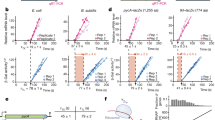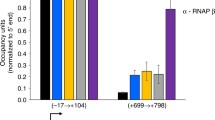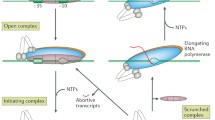Abstract
An efficiently expressed “tagged” gene system was used to study promoter sequence elements in genes encoding the U3 snoRNAs of Schizosaccharomyces pombe. Transcription was found dependent on two previously thought, mutually exclusive elements, a TATA-box, as found in other S. pombe snRNA gene promoters, and a Homol D-box, often considered a TATA-box analogue in the promoters of genes that encode ribosomal proteins. The Homol D-box is critical while the TATA-box strongly influences transcription efficiency but is not essential. The results suggest that the U3 snoRNA promoter may represent the fusion of two promoter systems reflecting the special role of this RNA in ribosome biogenesis. Steady state measurements of cellular RNAs support such a coordinated regulation of the U3 snoRNA.








Similar content being viewed by others
References
Beltrame M, Tollervey D (1995) Base pairing between U3 and the pre-ribosomal RNA is required for 18S rRNA synthesis. EMBO J 14:4350–4356
Birnboim HC, Doly J (1979) A rapid alkaline extraction procedure for screening recombinant plasmid DNA. Nucleic Acids Res 7:1513–1523
Chen D, Toone WM, Mata J, Lyne R, Burns G, Kivinen K, Brazma A, Jones N, Bähler J (2003) Global transcriptional responses of fission yeast to environmental stress. Mol Biol Cell 14:214–229
Dahlberg JE, Lund E (1988) The genes and transcription of the major small nuclear RNAs. In: Birnstiel ML (ed) Sructure and function of major and minor small nuclear ribonucleoprotein particles. Springer-Verlag, Berlin, pp 38–70
Gross T, Kaufer NF (1998) Cytoplasmic ribosomal protein genes of the fission yeast Schizosaccharomyces pombe display a unique promoter type: a suggestion for nomenclature of cytoplasmic ribosomal proteins in databases. Nucleic Acids Res 26:3319–3322
Gutz H, Heslot H, Leupoid U, Loprieno N (1974) Handbook of genetics. Plenum, New York Corp, pp 395–446
Hernandez N (2001) Small nuclear RNA genes: a model system to study fundamental mechanisms of transcription. J Biol Chem 276:26733–26736
Hoffman CS, Winston F (1987) A ten-minute DNA preparation from yeast efficiently releases autonomous plasmids for transformation of Escherichia coli. Gene 57:267–272
Hughes JMX, M Ares Jr (1991) Depletion of U3 small nucleolar RNA inhibits cleavage in the 5′ external transcribed spacer of yeast pre-ribosomal RNA and impairs formation of 18S ribosomal RNA. EMBO J 13:4231–4239
Hughes JM, Konings DA, Cesareni G (1987) The yeast homologue of U3 snRNA. EMBO J 7:2145–2155
Kass S, Tyc K, Steitz JA, Solner-Webb B (1990) The U3 small nucleolar ribonucleoprotein functions in the first step of preribosomal RNA processing. Cell 60:897–908
Kief DR, Warner JR (1981) Coordinate control of syntheses of ribosomal ribonucleic acid and ribosomal proteins during nutritional shift-up in Saccharomyces cerevisiae. Mol Cell Biol 11:1007–1015
Losson R, Lacroute F (1983) Plasmids carrying the yeast OMP decarboxylase structural and regulatory genes: transcription regulation in a foreign environment. Cell 32:371–377
Marshallsay C, Connelly S, Filipowicz W (1992) Characterization of the U3 and U6 snRNA genes from wheat: U3 snRNA genes in monocot plants are transcribed by RNA polymerase III. Plant Mol Biol 6:973–983
Mead DA, Szczesna-Skorupa E, Kemper B (1986) Single-stranded DNA ‘blue’ T7 promoter plasmids: a versatile tandem promoter system for cloning and protein engineering. Protein Eng 1:67–74
Nabavi S, Nazar RN (2005) Simplified one-tube “megaprimer” polymerase chain reaction mutagenesis. Anal Biochem 345:346–348
Nabavi S, Nellimarla S, Nazar RN (2008) Post-transcriptional regulation of the U3 small nucleolar RNA. J Biol Chem 283:21404–21410
Nazar RN (1991) Higher order structure of the ribosomal 5 S RNA. J Biol Chem 266:4562–4567
Okazaki K, Okazaki N, Kume K, Jinno S, Tanaka K, Okayama H (1990) High-frequency transformation method and library transducing vectors for cloning mammalian cDNAs by trans-complementation of Schizosaccharomyces pombe. Nucleic Acids Res 18:6485–6489
Porter GL, Brennwald PJ, Holm KA, Wise JA (1988) The sequence of U3 from Schizosaccharomyces pombe suggests structural divergence of this snRNA between metazoans and unicellular eukaryotes. Nucleic Acids Res 16:10131–10152
Rose MD, Winston F, Hieter P (1990) Methods in yeast genetics. Cold Spring Harbour Press, NY
Rudra D, Warner JR (2004) What better measure than ribosome synthesis?. Genes Dev 15: 20:2431–2436
Sambrook J, Russell WD (2001) Molecular cloning: a laboratory manual. Cold Spring Harbor Laboratory, Cold Spring Harbour, pp 8.51–8.53
Savino R, Gerbi SA (1990) In vivo disruption of Xenopus U3 snRNA affects ribosomal RNA processing. EMBO J 7:2299–2308
Savino R, Hitti Y, Gerbi SA (1992) Genes for Xenopus laevis U3 small nuclear RNA. Nucleic Acids Res 20:5435–5442
Selinger DA, Porter GL, Brennwald PJ, Wise JA (1992) The two similarly expressed genes encoding U3 snRNA in Schizosaccharomyces pombe lack introns. Mol Biol Evol 9:297–308
Smale ST, Kadonaga JT (2003) The RNA polymerase II core promoter. Annu Rev Biochem 72:449–479
Steele WJ, Okamura N, Busch H (1965) Effects of thioacetamide on the composition and biosynthesis of nucleolar and nuclear ribonucleic acids in rat liver. J Biol Chem 240:1742–1749
Tanay A, Regev A, Shamir R (2005) Conservation and evolvability in regulatory networks: the evolution of ribosomal regulation in yeast. Proc Natl Acad Sci USA 102:7203–7208
Witt I, Kwart M, Gross T, Kaufer NF (1995) The tandem repeat AGGGTAGGGT is, in the fission yeast, a proximal activation sequence and activates basal transcription mediated by the sequence TGTGACTG. Nucleic Acids Res 23:4296–4302
Zhou D, Lobo-Ruppert SM (2001) Transcription of the Schizosaccharomyces pombe U2 gene in vivo and in vitro is directed by two essential promoter elements. Nucleic Acids Res 29:2003–2011
Acknowledgments
This study was supported by the Natural Sciences and Engineering Research Council of Canada.
Author information
Authors and Affiliations
Corresponding author
Additional information
Communicated by S. Hohmann.
Rights and permissions
About this article
Cite this article
Nabavi, S., Nazar, R.N. U3 snoRNA promoter reflects the RNA’s function in ribosome biogenesis. Curr Genet 54, 175–184 (2008). https://doi.org/10.1007/s00294-008-0210-1
Received:
Revised:
Accepted:
Published:
Issue Date:
DOI: https://doi.org/10.1007/s00294-008-0210-1




